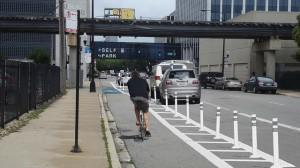
Cities across the country are building protected bike lanes, finding that they promote exercise and economic development while offering a clean alternative mode of transportation.
While road bikers and bicycle messengers often prefer “open” bike lanes that flow next to vehicular traffic, they come with several downsides. As a cyclist, I frequently encounter road debris including nails and broken glass (to the point it seems intentional), road kill, jarring drain hole covers, bad parallel parkers, and must constantly beware of car doors swinging into my path. These obstacles are an acceptable tradeoff for cyclists willing to give up a little safety for speed, but this sentiment is not shared by everyone.
Studies show that protected bike lanes, which feature a physical barrier (such as a curb or plastic post) between cars and cyclists, are preferred by the wider community due to safety concerns. A recent study published in the American Journal of Public Health found that compared to roads without any biking infrastructure, the risk of injury for riders on protected lanes dropped by 90 percent while roadside bike lanes saw a drop of just 50 percent. Since safer bike lanes are used more often (all things equal), it could be argued that they would be a greater source of public health. A 2008 study in the Journal of Physical Activity and Health found a strong inverse relationship between the occurrence of obesity and active transportation.
In addition to safety and health benefits, studies cited in a USA Today article support the notion that protected bike lanes benefit business communities. The New York City Department of Transportation found that after installing protected lanes in 2007, nearby small businesses experienced much higher sales growth than the borough average. Another study out of Portland State University compared the spending habits of drivers and cyclists, and found that while drivers spent more per visit, cyclists shopped more frequently and spent more overall. After Google-Motorola Mobility moved its headquarters to Kinzie St., Chicago Mayor Rahm Emanuel argued that streets with bike lanes also have the potential to attract businesses.
While protected bike lanes are safest, all bike lanes can provide immense environmental benefit if cars are taken off the road. In the case of the bike sharing program, Denver B-cycle, the group estimated that 43 percent of the trips completed with its bikes mitigated car trips. The organization estimates this prevented 312,121 lbs of carbon dioxide and nearly 10,000 lbs of toxic air pollutants from being released—not to mention financial savings of more than $41,000 and $311,000 in gas and parking expenses. A PubMed study based in Barcelona estimated that bike trips prevented nearly 20,000 lbs of carbon dioxide in 2011.
Only 62 protected bike lanes were built between 1874 and 2011, but 40 additional lanes were constructed by the end of 2012 and 100 more are planned in 2013. Though frequently the target of obnoxious and uninformed rants and raves, research shows that bike lanes benefit communities as a whole—whether they know it or not.
Image by Chicago Bicycle Program




